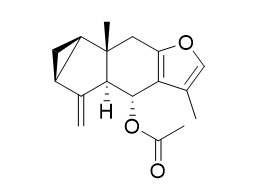Linderene acetate
Linderene acetate is a competitive inhibitor against Prolyl endopeptidase.
Inquire / Order:
manager@chemfaces.com
Technical Inquiries:
service@chemfaces.com
Tel:
+86-27-84237783
Fax:
+86-27-84254680
Address:
1 Building, No. 83, CheCheng Rd., Wuhan Economic and Technological Development Zone, Wuhan, Hubei 430056, PRC
Providing storage is as stated on the product vial and the vial is kept tightly sealed, the product can be stored for up to
24 months(2-8C).
Wherever possible, you should prepare and use solutions on the same day. However, if you need to make up stock solutions in advance, we recommend that you store the solution as aliquots in tightly sealed vials at -20C. Generally, these will be useable for up to two weeks. Before use, and prior to opening the vial we recommend that you allow your product to equilibrate to room temperature for at least 1 hour.
Need more advice on solubility, usage and handling? Please email to: service@chemfaces.com
The packaging of the product may have turned upside down during transportation, resulting in the natural compounds adhering to the neck or cap of the vial. take the vial out of its packaging and gently shake to let the compounds fall to the bottom of the vial. for liquid products, centrifuge at 200-500 RPM to gather the liquid at the bottom of the vial. try to avoid loss or contamination during handling.
Evid Based Complement Alternat Med.2021, 8855980.
Molecules.2022, 27(7):2093.
Sci Rep. 2017, 8207(7)
J Appl Biol Chem.2024, 67:47,337-343.
NanoBioScience2024, v13:3:115.
J Agric Food Chem.2015, 63(44):9869-78
Plant Cell Tiss Org2020, 1-16
Curr Issues Mol Biol.2023, ;45(2):1601-1612.
Internoational J of Toxicology2020, 10.1177.
Herbal Formula Science2024, 32(3):203-221
Related and Featured Products
Biol Pharm Bull. 2002 Aug;25(8):1049-52.
Prolyl endopeptidase inhibitors from the roots of Lindera strychnifolia F. Vill.[Pubmed:
12186408]
Prolyl endopeptidase (PEP, EC 3.4.21.26) has been proposed to play a role in degradation of proline-containing neuropeptides involved in the processes of learning and memory, e.g., vasopressin, substance P, and thyrotropin-releasing hormone (TRH).
METHODS AND RESULTS:
In the course of our search for bioactive constituents in medicinal plants, we studied the PEP inhibitory constituents of the roots of Lindera strychnifolia F. VILL and isolated two known tannins, epicatechin (1) and aesculitannin B (2), and four known sesquiterpenes, linderene (3), Linderene acetate (4), linderalactone (5) and isolinderalactone (6) as inhibitors. On the inhibitory activities of six compounds against PEP from Flavobacterium meningosepticum and that from rat brain supernatant, compounds 1, 2 and 4 inhibited the enzyme from Flavobacterium more strongly than that from rat brain supernatant. However, compounds 3, 5 and 6 inhibited the enzymes from both origins to the same extent and furthermore, compound 6 was the strongest natural inhibitor against PEP from rat brain supernatant.
CONCLUSIONS:
The kinetic study of these inhibitors indicated that compounds 1, 2 are noncompetitive inhibitors and compounds 3-6 are competitive inhibitors. This is the first example of non-phenolic constituents showing significant competitive inhibitory activity being isolated from natural medicines.



